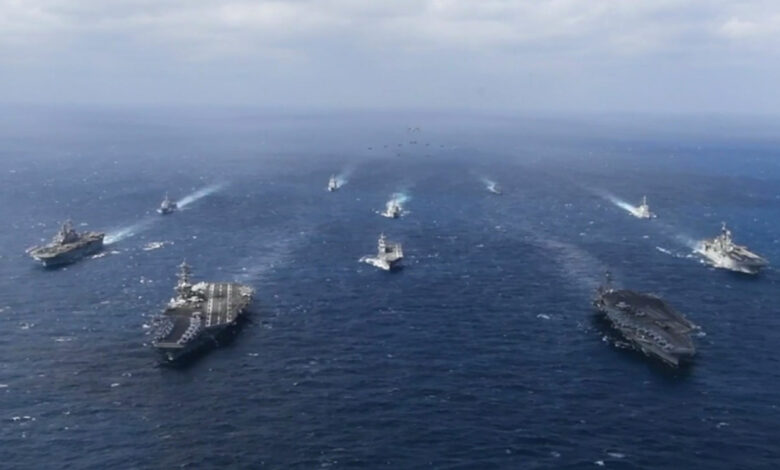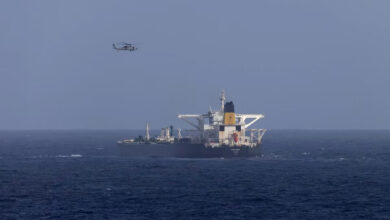
Tokyo (CNN) – Japanese Prime Minister Fumio Kishida is a man on a mission.
Since Russia invaded Ukraine in February, he has imposed sanctions on Moscow, agreed to pursue a nuclear-free world with the Pope and taken a diplomatic tour of Southeast Asia and Europe to rally world leaders to protect democracy.
But it’s not just democracy in Ukraine that he’s trying to protect — Kishida sees parallels between Russia’s actions in Europe and China’s expansion in the Indo-Pacific, a region stretching from America’s Pacific coastline to the Indian Ocean.
“We strongly oppose any unilateral attempt to change the status quo by force, regardless of the location,” said Kishida, in a joint statement with European Union leaders in May. The same statement included a clause expressing “serious concern about reports of militarization, coercion and intimidation in the South China Sea,” though it didn’t name China as the aggressor.
Japan’s location places it in an increasingly volatile security environment — flanked by China to its south, nuclear-armed North Korea to the west and Russia to its north. As a result, the war in Ukraine has catalyzed debates on Japan’s national security like never before.
In April, members of the country’s ruling party submitted a proposal to raise the country’s defense budget from 1% to 2% — in line with NATO members — and develop “counter-attack capabilities” — a move that heralds big changes for Japan’s longstanding pacifist security stance.
But Tokyo is not only investing in its defense, it’s using diplomacy to strengthen its relationships in the region and beyond. Ahead of Kishida’s meeting with United States President Joe Biden on Monday, experts say the world’s third-largest economy is reevaluating its approach to deterrence and showcasing itself as a reliable partner on the world stage.
A Japanese invention
Japan floated its idea of an “arc of freedom and prosperity” that would stretch across the Indo-Pacific and draw in the US and Australia more than a decade ago.
In 2007, then Japanese Prime Minister Shinzo Abe told Indian lawmakers that a “broader Asia” was beginning to form and implored Delhi to work alongside Tokyo “to nurture and enrich these seas.” It was the start of what would become the Quadrilateral Security Dialogue (Quad), a loose strategic alliance between the US, Australia, India and Japan.
Abe’s attempts to unite Pacific allies came as China was overtaking Japan as the world’s second-largest economy. Before long, Beijing was promoting its Belt and Road Initiative (BRI) to develop new trade routes connecting China with the world.
China claims sovereignty almost all of the 1.3 million square mile South China Sea, and has turned multiple reefs and sandbars — far from its shoreline — into man-made artificial islands heavily fortified with missiles, runways and weapons systems.
Observers worried that China’s expansion could eventually allow Beijing to control waterways in the South China Sea, threatening the free flow of trade, so in 2016, Abe upgraded his idea and introduced the concept of the “free and open Indo-Pacific (FOIP).”
Under FOIP, like-minded countries and organizations across Southeast Asia and Africa would safeguard the Indo-Pacific, and the trillions of dollars of goods that pass through it each year.
Cleo Paskal, an Indo-Pacific strategist at the Foundation for Defense of Democracies, said countries were initially slow to catch on to FOIP. “Many people didn’t think FOIP was even an issue as they assumed the seas would be open and people would be free,” she said. “But now we’re realizing that those two things of being free and open are actually under threat.”
China’s expansion in the region is expected to be one of the main points of discussion when Quad leaders meet in Tokyo on Tuesday, after Kishida’s bilateral with Biden.
Forging a stronger US security pact
Japan’s efforts to unite its democratic allies paid off when the US adopted FOIP in 2017, giving extra clout to the concept along with new resources, programs and partnerships.
But now analysts say the US expects Japan to take on a stronger leadership role in the region, and Tokyo knows that means it needs to step up its defenses.
“Japan recognizes that if it relies solely on the United States that wouldn’t really sustain the political confidence between the two sides,” said Ken Jimbo, a national security expert and professor at Keio University.
Last December Kishida announced the government was exploring options to give Japan the capability to strike enemy bases. Since then, calls have intensified from within Japan’s ruling party to develop “counterattack capabilities” in coordination with the US. The move would stretch the limits of the country’s pacifist constitution but expand Tokyo’s ability to retaliate against mobile and submarine-launched attacks.
“Japan wants to be able to stand up for itself in a fight. The country has a very strong section of the population who don’t want to be reliant on outside powers in order to be able to make decisions that might or may not risk its sovereignty,” Paskal said.
However, there’s resistance within the country to any move away from Japan’s pacifist stance.
“Popular public opinion still views Japan as a pacifist country that shouldn’t have the ability to attack others, it should only have sufficient means in order to defend itself,” said James Brown, an international relations expert at Temple University.
“So that concern has made the government move more slowly on this.”
However, the war in Ukraine seems to be shifting attitudes. A recent poll conducted by Asahi Shimbun and the University of Tokyo showed 64% of 3,000 people surveyed were in favor of Japan strengthening its defensive capabilities — the highest percentage since the survey started in 2003.
Managing China’s influence
China’s support of Russia’s actions in Ukraine has strengthened Kishida’s mission to protect the integrity of the Indo-Pacific. Not only is he reaching out to larger allies in the US and Europe, he’s engaging in diplomacy closer to home to make it clear Japan is a partner that can be relied upon in uncertain times.
In March, a Japanese delegation visited the Solomon Islands after China and Honiara signed a security pact that some feared could eventually see a Chinese military base in the Pacific. Paskal, the Indo-Pacific analyst, said the diplomatic trip highlights Tokyo’s interest in positioning itself as an alternative security provider.
Japan also wants to offer an alternative to China by showcasing its own quality infrastructure projects, which use local labor, have high-quality controls and don’t leave unsustainable debt burdens in participating countries, said Thomas Wilkins, a senior fellow at the Australian Strategic Policy Institute.
Tokyo’s efforts have not gone unnoticed in Beijing.
During a video call with his Japanese counterpart on Wednesday, Chinese Foreign Minister Wang Yi said that even before Biden’s arrival in Asia, the perception that Japan and the US were united against China “was already rampant” and had created “a foul atmosphere,” according to a Chinese Foreign Ministry statement.
Japan’s assertive response to Russia’s invasion of Ukraine is on brand for a country that’s trying to strengthen democratic ties in its own region.
When Quad members meet in Tokyo on Tuesday, they’ll be looking to present a united front that fits with Japan’s original vision of the “arc of freedom and prosperity.”
Paskal said in that regard Japan’s leadership in the region was “respected and appreciated.”
“There’s a lot left to be done, but it is moving in a way that many Japan watchers may not have expected even five years ago,” she said.




